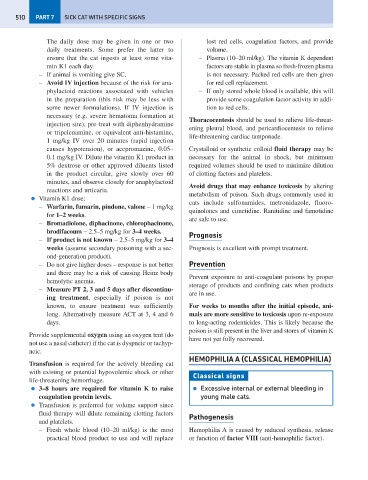Page 518 - Problem-Based Feline Medicine
P. 518
510 PART 7 SICK CAT WITH SPECIFIC SIGNS
The daily dose may be given in one or two lost red cells, coagulation factors, and provide
daily treatments. Some prefer the latter to volume.
ensure that the cat ingests at least some vita- – Plasma (10–20 ml/kg). The vitamin K dependent
min K1 each day. factors are stable in plasma so fresh-frozen plasma
– If animal is vomiting give SC. is not necessary. Packed red cells are then given
– Avoid IV injection because of the risk for ana- for red cell replacement.
phylactoid reactions associated with vehicles – If only stored whole blood is available, this will
in the preparation (this risk may be less with provide some coagulation factor activity in addi-
some newer formulations). If IV injection is tion to red cells.
necessary (e.g. severe hematoma formation at
Thoracocentesis should be used to relieve life-threat-
injection site), pre-treat with diphenhydramine
ening pleural blood, and pericardiocentesis to relieve
or tripelenamine, or equivalent anti-histamine,
life-threatening cardiac tamponade.
1 mg/kg IV over 20 minutes (rapid injection
causes hypotension), or acepromazine, 0.05– Crystalloid or synthetic colloid fluid therapy may be
0.1 mg/kg IV. Dilute the vitamin K1 product in necessary for the animal in shock, but minimum
5% dextrose or other approved diluents listed required volumes should be used to minimize dilution
in the product circular, give slowly over 60 of clotting factors and platelets.
minutes, and observe closely for anaphylactoid
Avoid drugs that may enhance toxicosis by altering
reactions and urticaria.
metabolism of poison. Such drugs commonly used in
● Vitamin K1 dose:
cats include sulfonamides, metronidazole, fluoro-
– Warfarin, fumarin, pindone, valone − 1 mg/kg
quinolones and cimetidine. Ranitidine and famotidine
for 1–2 weeks.
are safe to use.
– Bromadiolone, diphacinone, chlorophacinone,
brodifacoum − 2.5–5 mg/kg for 3–4 weeks.
Prognosis
– If product is not known − 2.5–5 mg/kg for 3–4
weeks (assume secondary poisoning with a sec- Prognosis is excellent with prompt treatment.
ond-generation product).
– Do not give higher doses – response is not better Prevention
and there may be a risk of causing Heinz body
Prevent exposure to anti-coagulant poisons by proper
hemolytic anemia.
storage of products and confining cats when products
– Measure PT 2, 3 and 5 days after discontinu-
are in use.
ing treatment, especially if poison is not
known, to ensure treatment was sufficiently For weeks to months after the initial episode, ani-
long. Alternatively measure ACT at 3, 4 and 6 mals are more sensitive to toxicosis upon re-exposure
days. to long-acting rodenticides. This is likely because the
poison is still present in the liver and stores of vitamin K
Provide supplemental oxygen using an oxygen tent (do
have not yet fully recovered.
not use a nasal catheter) if the cat is dyspneic or tachyp-
neic.
HEMOPHILIA A (CLASSICAL HEMOPHILIA)
Transfusion is required for the actively bleeding cat
with existing or potential hypovolemic shock or other
Classical signs
life-threatening hemorrhage.
● 3–8 hours are required for vitamin K to raise ● Excessive internal or external bleeding in
coagulation protein levels. young male cats.
● Transfusion is preferred for volume support since
fluid therapy will dilute remaining clotting factors
Pathogenesis
and platelets.
– Fresh whole blood (10–20 ml/kg) is the most Hemophilia A is caused by reduced synthesis, release
practical blood product to use and will replace or function of factor VIII (anti-hemophilic factor).

